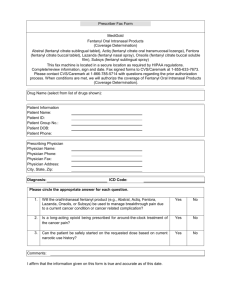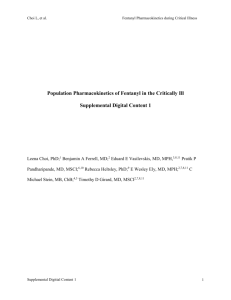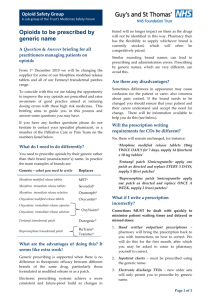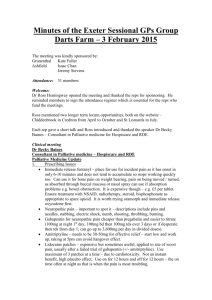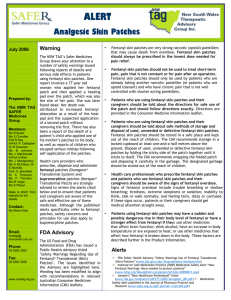What Fentanyl Orion contains
advertisement
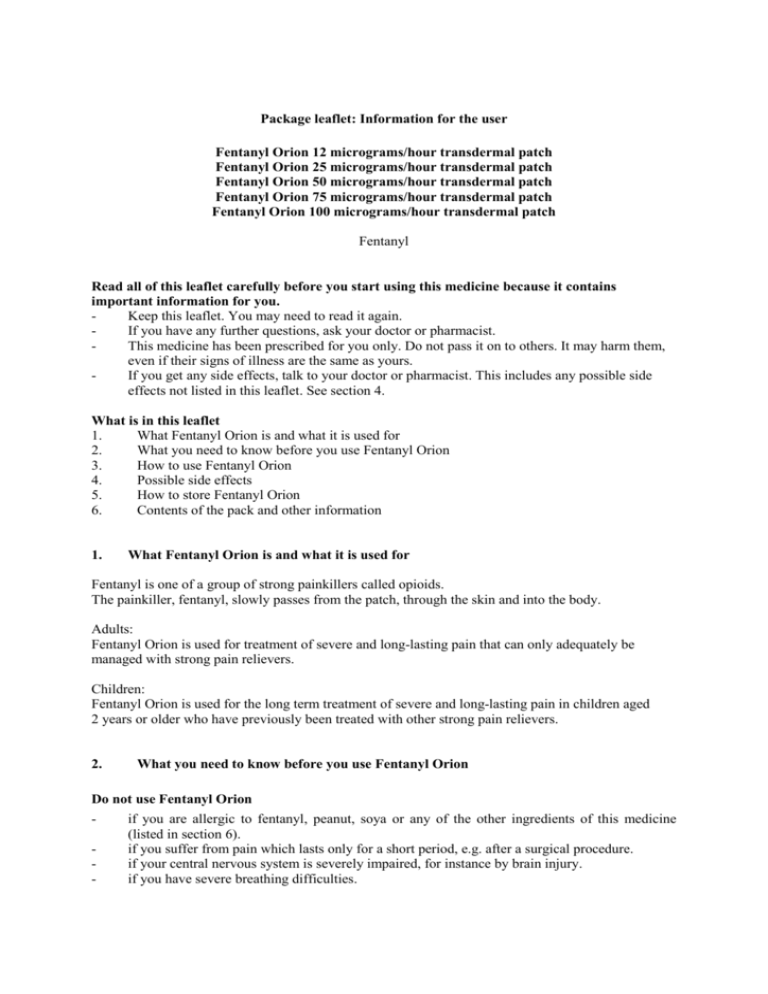
Package leaflet: Information for the user Fentanyl Orion 12 micrograms/hour transdermal patch Fentanyl Orion 25 micrograms/hour transdermal patch Fentanyl Orion 50 micrograms/hour transdermal patch Fentanyl Orion 75 micrograms/hour transdermal patch Fentanyl Orion 100 micrograms/hour transdermal patch Fentanyl Read all of this leaflet carefully before you start using this medicine because it contains important information for you. Keep this leaflet. You may need to read it again. If you have any further questions, ask your doctor or pharmacist. This medicine has been prescribed for you only. Do not pass it on to others. It may harm them, even if their signs of illness are the same as yours. If you get any side effects, talk to your doctor or pharmacist. This includes any possible side effects not listed in this leaflet. See section 4. What is in this leaflet 1. What Fentanyl Orion is and what it is used for 2. What you need to know before you use Fentanyl Orion 3. How to use Fentanyl Orion 4. Possible side effects 5. How to store Fentanyl Orion 6. Contents of the pack and other information 1. What Fentanyl Orion is and what it is used for Fentanyl is one of a group of strong painkillers called opioids. The painkiller, fentanyl, slowly passes from the patch, through the skin and into the body. Adults: Fentanyl Orion is used for treatment of severe and long-lasting pain that can only adequately be managed with strong pain relievers. Children: Fentanyl Orion is used for the long term treatment of severe and long-lasting pain in children aged 2 years or older who have previously been treated with other strong pain relievers. 2. What you need to know before you use Fentanyl Orion Do not use Fentanyl Orion - if you are allergic to fentanyl, peanut, soya or any of the other ingredients of this medicine (listed in section 6). if you suffer from pain which lasts only for a short period, e.g. after a surgical procedure. if your central nervous system is severely impaired, for instance by brain injury. if you have severe breathing difficulties. Warnings and precautions Talk to your doctor or pharmacist before using Fentanyl Orion. WARNING: Fentanyl Orion is a medicinal product that could be life-threatening to children. This is also the case with used transdermal patches. Bear in mind that the design of this medicinal product could be tempting to a child which in some cases may lead to a fatal outcome. Fentanyl Orion can have life-threatening side-effects in persons that are not using prescribed opioid medicines on a regular basis. Keep this product out of the sight and reach of children before and after use. Your doctor will use the treatment with Fentanyl Orion as a part of an integrated treatment of pain and will regularly monitor you for your individual response to Fentanyl Orion. Before starting to use Fentanyl Orion you should inform your doctor if you suffer from any of the below conditions, because the risk of side effects is higher and/or your doctor may need to prescribe a lower dose of fentanyl. asthma, respiratory depression or any lung disease low blood pressure or low blood volume impaired liver function impaired kidney function if you have had a head injury, a brain tumour, signs of increased intracranial pressure (e.g. headache, visual disturbances), changes in your state of consciousness or loss of consciousness or coma slow irregular heartbeat (bradyarrhythmias) myasthenia gravis (a disease causing tiredness and weakness of the muscles) chronic constipation Constipation Fentanyl Orion can cause constipation. Talk to your doctor or pharmacist for advice on how to prevent constipation. Serotonin syndrome Tell your doctor if you are using or have recently used certain medicines to treat depression called selective serotonin reuptake inhibitors (SSRIs), serotonin–norepinephrine reuptake inhibitors (SNRIs) or medicines known as monoamine oxidase (MAO) inhibitors (e.g. moclobemide against depression or selegiline against Parkinson’s disease). Concomitant use with Fentanyl Orion and these medicines may increase the risk of so called serotonin syndrome, a potentially life-threatening condition. Signs and symptoms of serotonin syndrome may include a combination of the following: agitation, hallucinations, coma, rapid heart rate, fast changes in blood pressure, increased body temperature, overactive reflexes, loss of coordination, rigidity, diarrhoea, nausea and vomiting. Get medical care right away if you think serotonin syndrome is happening to you. Fever and external heat Inform your doctor if you develop fever during the treatment, as increased body temperature may cause too much medicine to pass through the skin and result in overdose or even death. For the same reason you should avoid exposing the patch on the skin to direct heat, such as heating pads, electric blankets, hot-water bottles, heat or tanning lamps, heated water beds, and prolonged saunas, hot baths and hot whirlpool spa baths. Avoid also intensive sunbathing. It is allowed to stay outside in the sun, but you must protect the patch with some piece of clothing during hot summer days. Drug dependence Like with many other strong painkillers, tolerance, physical or psychological dependence may develop if you use Fentanyl Orion for a longer period. However, this is rarely seen during treatment of pain due to cancer. Tell your doctor if you have a history of drug dependence or alcohol abuse, because your risk of dependence might be increased and the doctor may want to monitor your drug use more closely. Abuse or intentional misuse of this medicine may result in overdose or death. Older people and emaciated patients If you are an elderly patient or if you are in a very bad physical condition (cachectic), your doctor will monitor you more carefully, because it may be necessary to prescribe a lower dose. Patch sticking to another person The patch should be used only on the skin of the person for whom it was ordered by the doctor. Cases have been reported where a patch was accidentally stuck to a family member while in close physical contact or sharing the same bed as the patch wearer. A patch sticking to another person (particularly a child) may result in an overdose. In case the patch sticks to the skin of another person, take the patch off immediately and seek medical attention. Handling of patches The patches should not be cut into smaller parts, because the quality, efficacy and safety of such divided patches have not been demonstrated. Children Fentanyl Orion may only be used in children aged 2 years or older who have previously been treated with other opioids (e.g. morphine). Fentanyl Orion should not be used in infants and toddlers under 2 years of age. To guard against accidental ingestion by children, caution should be used when choosing the application site for Fentanyl transdermal patch (see section 3. How to use Fentanyl Orion) and the adhesion of the patch should be monitored closely. Other medicines and Fentanyl Orion Please tell your doctor if you use barbiturates (used for treating sleep disorders), buprenorphine, nalbuphine or pentazocine (other strong painkillers). It is not recommended to use those together with Fentanyl Orion because they may reduce or increase the effects of fentanyl, and induce withdrawal symptoms in opioid-dependent patients. Do not take concomitantly with Fentanyl Orion other medicines that depress function of the central nervous system, as this might result in breathing difficulties, low blood pressure, profound sedation, coma or death. This applies, for example, to: medicines used for treating anxiety (anxiolytics and tranquillisers) medicines used for treating depression (antidepressants), e.g. nefazodone medicines used for treating psychological disorders (neuroleptics) general anaesthetics, if you think you are going to have general anaesthesia, tell the doctor or dentist that you are using Fentanyl Orion some medicines for back pain or other painful musculoskeletal conditions (muscle relaxants) medicines used for treating sleep disorders (hypnotics, sedatives) medicines used for treating allergies or travel sickness (antihistamines/antiemetics) other strong painkillers of the opioid group alcohol You should not take the medicines listed below at the same time as you are using Fentanyl Orion, unless you are closely monitored by your doctor. These medicines may increase the effects and side effects of Fentanyl Orion and even cause serious respiratory depression. This applies, for example, to: ritonavir, saquinavir, nelfinavir (used to treat AIDS) ketoconazole, itraconazole, voriconazole (used to treat fungal diseases) diltiazem, verapamil, amiodarone (used to treat heart diseases) cimetidine (used to treat gastrointestinal diseases) macrolide antibiotics (used to treat infections), e.g. clarithromycin, erythromycin, telithromycin, troleandomycin Tell your doctor if you are taking or have recently been taking medicines called CYP3A4 inducers, for example: - rifampicin (antibiotics used to treat tuberculosis) - carbamazepine, phenobarbital, phenytoin (medicines used to treat epilepsy) These medicines may reduce the effect of Fentanyl Orion and a dose adjustment may be necessary. Serotonin syndrome Tell your doctor or pharmacist if you are using certain medicines to treat depression called selective serotonin reuptake inhibitors (SSRIs), serotonin–norepinephrine reuptake inhibitors (SNRIs) or medicines known as monoamine oxidase (MAO) inhibitors (e.g. moclobemide against depression or selegiline against Parkinson’s disease). Your doctor should be aware if you are using these medicines, or have been using them within the last 14 days, because concomitant use with Fentanyl Orion may increase the risk of serotonin syndrome, a potentially life-threatening condition. For more information see section “Warnings and precautions”. Tell your doctor or pharmacist if you are taking, have recently taken, or might take any other medicines, including medicines obtained without a prescription. Fentanyl Orion with food, drink and alcohol Simultaneous use of Fentanyl Orion and alcoholic beverages increases the risk of severe adverse reactions, and may cause breathing difficulties, a fall of blood pressure, profound sedation and coma. Pregnancy and breast-feeding If you are pregnant or breast-feeding, think you may be pregnant or are planning to have a baby, ask your doctor or pharmacist for advice before taking this medicine. Pregnancy Fentanyl Orion should not be used during pregnancy unless clearly necessary, because the safety of fentanyl in pregnancy remains unknown. If you get pregnant during treatment with Fentanyl Orion , consult your doctor. The use of Fentanyl Orion during labour and delivery is not recommended, because fentanyl is not appropriate for management of short-term pain and because it may cause breathing problems in the newborn infant. Breast-feeding You should not breastfeed during treatment with Fentanyl Orion. Fentanyl passes into breast-milk and may cause side effects in the breast-fed infant as sedation and respiratory depression. Any breast milk produced during treatment or within 72 hours after the removal of the last patch should be discarded. Driving and using machines Fentanyl Orion has major influence on the ability to drive and use machines. This has to be expected especially at the beginning of treatment, at any change of dosage as well as in connection with alcohol or tranquilizers. If you have been using the same dose of Fentanyl Orion for a longer period of time, your doctor may decide that you are permitted to drive and use dangerous machines. Do not drive or operate dangerous machines while using Fentanyl Orion, unless your doctor has told you that such is permitted. 3. How to use Fentanyl Orion Always use this medicine exactly as your doctor or pharmacist has told you. Check with your doctor or pharmacist if you are not sure. Your doctor will decide which strength of Fentanyl Orion is most suitable for you. Your doctor will base his judgement on: the severity of your pain, your general condition and the type of pain treatment that you have received so far. According to your reaction the strength of the patch or the number of patches may need to be adjusted. The effect is reached within 24 hours after the first patch has been applied and its effects fall gradually after the patch is removed. Do not discontinue treatment without consulting your doctor. Unless otherwise prescribed by your physician, the normal dosage is: The patch strength should always be adapted to the severity of pain and the sensitivity of the individual patient. Determining the treatment amount (dosage adjustment) If you have not previously received strong painkillers (analgesics), treatment should be initiated with the lowest concentration of the active substance. Since the concentration of fentanyl in the bloodstream rises slowly, the current analgesic treatment should be stopped no earlier than 12 hours after the patch has been applied. After this time, it is oriented to need. Fundamentally, the maximum analgesic effect can only be assessed after approx. 24 hours. When switching from other strongly acting analgesics to Fentanyl Orion the 24-hour requirement of the previously administered strong analgesic should first be calculated by your physician. Dosage for maintaining the effect If the analgesic effect is still insufficient after 72 hours, the dosage may be increased step by step by an additional 25 micrograms/hour until the desired analgesic effect is obtained. The possible need for other analgesics and the patient’s sensation of pain should be taken into account. Use of several patches simultaneously If the required dosage exceeds 100 micrograms fentanyl per hour, several patches of differing strength may be used simultaneously. Additional or alternative methods of analgesic treatment should be considered if the required dosage exceeds 300 micrograms fentanyl per hour. Change of treatment If there is intent to switch from Fentanyl Orion to another strongly acting analgesic, the patch is removed, and the dosage of the new analgesic is adapted using the patient’s pain assessment. After switching or dosage reduction, some patients may experience opioid withdrawal symptoms (such as nausea, vomiting, diarrhoea, fear conditions and muscle trembling). If stoppage of Fentanyl Orion is necessary, step-by-step reduction of the dosage, e.g. by using a weaker patch, is recommended. Disturbed liver or kidney function In patients with disturbed liver or kidney function, the active substance amount should be reduced, if applicable. Use in children Your doctor will choose the use of Fentanyl Orion 12 micrograms/hour only if your child received at least 30–44 mg morphine as daily oral dose or other opioid analgesic agents equivalent to morphine. In cases of oral dosages of 45–134 mg your doctor will prescribe the use of Fentanyl Orion 25 micrograms/hour. For children who receive more than 90 mg oral morphine a day, only limited information is currently available. If the analgesic effect of Fentanyl Orion is insufficient, supplementary morphine or another shortduration opioid will be prescribed. Depending on the additional analgesic needs and the pain status of the child, the doctor may decide to increase the dose. The doctor will perform dose adjustments in steps of 12 micrograms fentanyl per hour. Older people Elderly patients should be carefully monitored for signs of overdose. A lower patch strength may have to be used. Feverish patients Dosage adaptation may be required in these patients during feverish periods. How and when to use Fentanyl Orion Apply Fentanyl Orion immediately after removal from the package and removal of the protective foil, onto a hairless smooth skin surface or an area from which the hair has been removed, in the region of the upper body (chest, back) or on the upper arm. Hair should not be shaved, but should be trimmed with scissors. If required, the skin should be cautiously cleaned with water and dried thoroughly before applying the patch. Do not use soaps, oils, lotions, alcohol or other products which may irritate the skin or influence its characteristics. Ensure that the treatment location does not show skin irritations or small injuries (e.g. after irradiation or shaving). Since the outside of the patch is protected by a waterproof cover foil, you can also wear it while showering. Children: In young children, the upper back is the preferred location to apply the patch, to minimize the potential of the child removing the patch. Only open the pouch immediately before use of the patch. Advice for opening child resistant sachet: 1) You’ll find a mark which shows you how to cut the sachet (using scissors!) 2) Rip the sachet alongside using the resulting cuts 3) Open the sachet and take out the patch Then remove the pull-off foil from half of the patch. It is important to avoid touching the adhesive surface. After sticking half of the patch onto the skin, you can remove the other half of the pull-off foil. Firmly press the patch onto the skin with your flat hand for 30–60 seconds. Ensure that the adhesive edges stick well. After applying the patch, wash your hands without using cleaning agents. The patch must not be damaged, separated or cut. A patch that has been divided, cut, or damaged in any way should not be used. It may occasionally be necessary to provide additional fastening for the patch. How long to use Fentanyl Orion Apply Fentanyl Orion continuously every 72 hours (3 days). The patch is then changed. If required in individual cases, do not change the patch sooner than every 48 hours, since an increased risk of side effects (primarily respiratory suppression) must otherwise be expected. Make a note of the date after applying a new patch. The following table will help you in precisely observing the 3-day interval and shows you which day of the week to change your patch: Apply your patch on Monday Tuesday Wednesday Thursday Friday Saturday Sunday → → → → → → → Change your patch at the same time on Thursday Friday Saturday Sunday Monday Tuesday Wednesday You must use a different skin area each time. Each used skin area can only be used again after at least 7 days. The physician decides the duration of treatment, depending on pain complaints. Please speak to your physician if you have the impression that the effect of Fentanyl Orion is too strong or weak for you. If you use more Fentanyl Orion than you should If you have stuck on more patches than prescribed, remove the patches and contact your doctor or hospital on their opinion of the risk. The most common sign of overdose is reduced ability to breathe. Symptoms are that the person breathes abnormally slowly or weakly. If this should occur – remove the patches and contact a doctor immediately. While waiting for the doctor, keep the person awake by talking to or shaking her/him now and then. Other signs and symptoms of overdose are drowsiness, low body temperature, slow heart rate, decreased muscle tone, deep sedation, loss of muscle co-ordination, constriction of the pupils and convulsions. If you forget to use Fentanyl Orion Do not under any circumstances use a double dose. You should change your patch at the same time of day every three days (every 72 hours), unless directed otherwise by your doctor. If you forget, then change your patch as soon as you remember. If you are very late changing your patch then you should contact your doctor because you might need some extra painkillers. If you stop using Fentanyl Orion If you wish to interrupt or stop the treatment, you should always talk to your doctor about the reasons for discontinuation and your continued treatment. Prolonged use of Fentanyl Orion can cause physical dependence. If you do stop using the patches you may feel unwell. As the risk of withdrawal symptoms is greater when the treatment is stopped suddenly, you should never stop treatment with Fentanyl Orion independently but always consult your doctor first. If you have any further questions on the use of this medicine, ask your doctor or pharmacist. 4. Possible side effects Like all medicines, this medicine can cause side effects, although not everybody gets them. If any of the following serious side effects occur, you should discontinue treatment and immediately contact your doctor or visit a hospital: life-threatening hypersensitivity reaction (anaphylactic shock or reaction) causing swelling of face, tongue or throat; difficulty swallowing; hives and breathing difficulties abnormally slow breathing. The frequency of the above side effects is not known (cannot be estimated from the available data). Other side effects are: Very common (may affect more than 1 in 10 people): sleepiness, headache, dizziness nausea, vomiting, constipation. Common (may affect up to 1 in 10 people): hypersensitivity loss of appetite sleeplessness, depression, anxiety, confusion, hallucinations shaking, sensation of pins and needles vertigo palpitations, rapid heart rate, high blood pressure shortness of breath diarrhoea, dry mouth, stomach pain, indigestion excessive sweating, itching, skin rash, redness of the skin muscle spasms difficulty in passing urine tiredness, swelling of hands, ankles or feet, weakness, general feelings of discomfort, feeling cold. Uncommon (may affect up to 1 in 100 people): agitation, loss of one’s sense of time and place (disorientation), exaggerated and unrealistic feeling of physical and mental well-being diminished sense of touch, seizure (including clonic and grand mal seizures), memory loss slow heart rate, bluish discoloration of the skin, low blood pressure difficulties in breathing intestinal obstruction various inflammations of the skin, skin disorder muscle twitching erectile or sexual dysfunction a reaction or hypersensitivity at the patch application site, influenza-like illness, feeling of body temperature change, drug withdrawal symptoms. Rare (may affect up to 1 in 1,000 people): tiny pupils temporarily stopping of breathing, unusually slow and shallow breathing partial intestinal obstruction inflammation of the skin at the patch application site. Additional side effects in children and adolescents The adverse effects in children and adolescents treated with Fentanyl Orion are similar to those observed in adults. No risk was identified in children and adolescents beyond that expected with the use of opioids for the relief of pain associated with serious illness. There did not appear to be any paediatric-specific risk associated with Fentanyl Orion use in children as young as 2 years old when used as directed. The very common adverse effects reported in children are fever, vomiting and nausea. Reduced efficacy of treatment If you have been using Fentanyl Orion for some time, it might happen that Fentanyl Orion will become less effective for you so that a dose adjustment will be necessary (tolerance may develop). Please consult your doctor about the need to adjust the dose. Withdrawal symptoms Prolonged use of this medicine may cause physical and psychological dependence. Do not stop using the patches suddenly, because you might experience withdrawal symptoms, such as nausea, vomiting, diarrhoea, anxiety and shivering. Please consult your doctor about how to gradually stop the treatment. See also Warnings and precautions, Drug dependence and How to use Fentanyl Orion, If you stop using Fentanyl Orion. Reporting of side effects If you get any side effects, talk to your doctor or pharmacist. This includes any possible side effects not listed in this leaflet. You can also report side effects directly via the national reporting system listed in Appendix V. By reporting side effects you can help provide more information on the safety of this medicine. 5. How to store Fentanyl Orion Keep unused and used Fentanyl Orion out of the sight and reach of children. High quantities of the active substance remain in the transdermal patches even after use. Do not use this medicine after the expiry date which is stated on the package. The expiry date refers to the last day of that month. This medicinal product does not require any special storage conditions. Disposal information High quantities of fentanyl remain in the transdermal patches even after use. Used patches should be folded so that the adhesive side of the patch adheres to itself and then they should be safely discarded. Accidental exposure to used and unused patches particularly in children may lead to a fatal outcome. Unused patches should be returned to the (hospital) pharmacy. Do not throw away any medicines via wastewater or household waste. Ask your pharmacist how to throw away medicines you no longer use. These measures are for safety reasons and will also help protect the environment. 6. Contents of the pack and other information What Fentanyl Orion contains The active substance is fentanyl. Fentanyl Orion 12 micrograms/hour: Each patch releases 12.5 micrograms fentanyl per hour. Each patch of 4.25 cm2 contains 2.55 mg fentanyl. Fentanyl Orion 25 micrograms/hour: Each patch releases 25 micrograms fentanyl per hour. Each patch of 8.5 cm2 contains 5.1 mg fentanyl. Fentanyl Orion 50 micrograms/hour: Each patch releases 50 micrograms fentanyl per hour. Each patch of 17 cm2 contains 10.2 mg fentanyl. Fentanyl Orion 75 micrograms/hour: Each patch releases 75 micrograms fentanyl per hour. Each patch of 25.5 cm2 contains 15.3 mg fentanyl. Fentanyl Orion 100 micrograms/hour: Each patch releases 100 micrograms fentanyl per hour. Each patch of 34 cm2 contains 20.4 mg fentanyl. The other ingredients are: Matrix components: Aloe vera leaf extract oil (on the basis of soya oil tocopherol acetate), pentaerythritol ester of hydrogenated rosin, poly(2-ethylhexylacrylate, vinyl acetate) (50:50) Release liner: polyester foil Backing foil with imprint: polyethylene terephthalate foil, printing colour What Fentanyl Orion looks like and contents of the pack Transdermal patch. Fentanyl Orion transdermal patch is an opaque, colourless, rectangular shaped patch with round corners and imprint on the backing foil: “fentanyl 12µg/h”/ “fentanyl 25µg/h”/ “fentanyl 50µg/h”/ “fentanyl 75µg/h”/ “fentanyl 100µg/h”/ Fentanyl Orion is available in packs containing 4, 5, 8, 10, 16 and 20 transdermal patches in single child-resistant sachets. Marketing Authorisation Holder and Manufacturer [To be completed nationally] This leaflet was last revised in 25 February 2016 [To be completed nationally]
